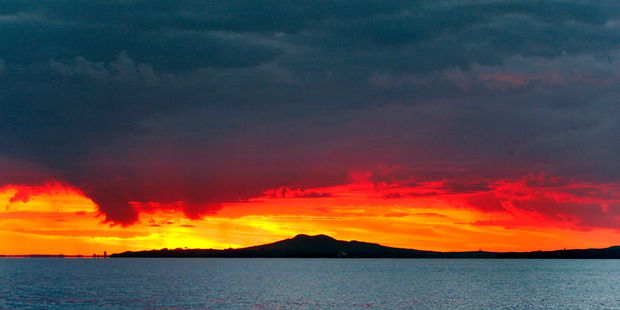Volcano hiding explosive secret
 The explosive history of Auckland's largest volcano has again been rewritten. Photo / Brett Phibbs
The explosive history of Auckland's largest volcano has again been rewritten. Photo / Brett Phibbs The explosive history of Auckland's largest volcano has again been rewritten, after scientists recovered buried clues of ancient blasts deep below Rangitoto Island.
The fresh evidence has suggested Rangitoto is much older than previously thought and could actually be not one volcano but a cluster of them - findings that could hold big implications for its risk to the city.
In a new study, a team of researchers who drilled into the offshore volcano last year have concluded it is about 6000 years old - and may have begun erupting around that point.
It comes after a series of developments over the past few years, when scientists have moved away from the long-held belief that Rangitoto was just 700 years old and had erupted only once or twice, between 500 and 550 years ago.
Last summer, the team drilled 150 metres below the volcano's surface to recover core samples, which were then analysed using radiocarbon dating technology.
Rangitoto, rising 260m out of the Hauraki Gulf, is unusually large compared with other Auckland volcanoes, representing a third to a half of all magma erupted over the entire history of the region.
Associate Professor Phil Shane, the Auckland University volcanologist who led the research team, suspects the volcano may actually even be a cluster of several small volcanoes beneath one single, large volcanic edifice.
"That suggests the volcano was intermittently active over a much longer period and grew over time rather than forming in one short burst," he said.
Geologists now wonder if the eruption behaviour of the Auckland volcanic field has changed.
Older volcanoes appear to have erupted in short bursts of just months or years, with no pattern to where they formed.
The traditional view was that a new volcano would probably form in a location that had not previously experienced an eruption.
It's important to consider that future eruptions could occur at the volcano or if a new volcano forms, it could be active for a very long time such as hundreds or thousands of years.Dr Phil Shane
In contrast, activity at Rangitoto continued for thousands of years, leading scientists to consider whether future activity will also occur in the general area of Rangitoto.
"It's important to consider that future eruptions could occur at the volcano or if a new volcano forms, it could be active for a very long time such as hundreds or thousands of years," Dr Shane said.
"That could mean people having to adapt to living with continuing volcanic activity as they do in Hawaii or Iceland."
The new results are published in the Geological Society of America Bulletin.
Rediscovering Rangitoto
2013: A study suggests that, contrary to the long-held belief Rangitoto formed 700 years ago and had erupted only twice, there may have actually been intermittent activity between 1500 years ago and 500 years ago.
2014: A major drilling project probes tens of metres into the volcano to recover dozens of core samples and build a more accurate picture of the volcano's eruptive history.
2016: After another big drill in summer 2015, a team led by Auckland University volcanologist Associate Professor Phil Shane concludes the volcano began erupting about 6000 years ago and may even be a cluster of volcanoes.
- NZ Herald
http://www.nzherald.co.nz/technology/news/article.cfm?c_id=5&objectid=11612508
--
__._,_.___

No comments:
Post a Comment